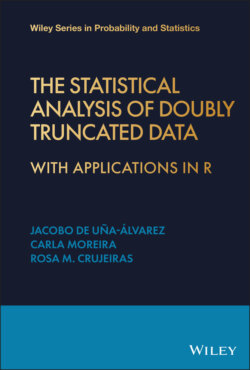Читать книгу The Statistical Analysis of Doubly Truncated Data - Prof Jacobo de Uña-Álvarez, Prof Carla Moreira - Страница 19
1.4.2 AIDS Blood Transfusion Data
ОглавлениеKalbfleish and Lawless (1989) reported 494 cases of transfusion‐related AIDS, corresponding to individuals diagnosed prior to 1 July 1986 (). The variable of ultimate interest is the induction or incubation time, which is the time elapsed from HIV infection to AIDS. Importantly, HIV was unknown before 1982 (); this implies that cases developing AIDS prior to this date were not reported. Let denote the time from HIV infection to 1 July 1986 (in months), and introduce ; then, due to the interval sampling, only triplets satisfying were observed (Bilker and Wang, 1996). We restrict our analysis to the cases with consistent data, for which the infection could be attributed to a single transfusion or a short series of transfusions. This dataset is fully reported in Kalbfleish and Lawless (1989), p. 361.
The observed values of range from 0.5 to 89 (months), while ranges from to 45.5. This suggests that the lower limit of the support of is about , while the upper limit of the support of is about 99.5. As discussed in Chapter 2, in such a case the distribution of the incubation time is identifiable on the interval (months). The AIDS Blood Transfusion Data also includes information on the age of the individual at infection; see Table 1.2.
Table 1.2 Descriptive statistics for the AIDS Blood Transfusion Data: sample size and mean (and standard deviation, SD) for the incubation time (months) by age at infection.
| Age group | Mean (SD) | |
|---|---|---|
| 30 years | 56 | 27.09 (18.28) |
| 30–60 years | 104 | 33.80 (18.95) |
| 60 years | 135 | 32.46 (16.74) |
This dataset is used in Chapters 2, 3, 4 and 5 and can be obtained from AIDS.DT in DTDA package.
